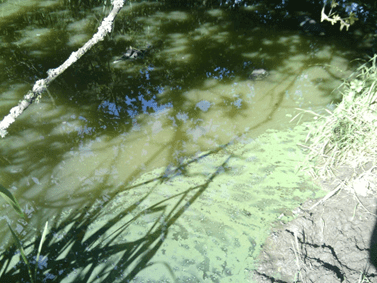What are blue-green algae?
Blue-green algae are minute organisms that occur naturally in lochs, ponds, reservoirs, rivers and in the sea. They tend to clump together to form large masses or scums. Blue-green algae commonly occurs in hot weather, in waters polluted by agricultural, domestic or industrial discharges.
In still waters, the algae can multiply during the summer months and discolour the water. It will appear green, blue-green, or greenish-brown. Sometimes a scum may form on the surface. This scum can appear in different places at different times but is most commonly found at the water’s edge or shoreline.

How do blue-green algae affect humans and animals?
Some blue-green algae release poisons into the water. It's not possible to tell which algae produce poisons without detailed examination in a laboratory. So we would advise you to regard all algal scums as poisonous.
The toxins of blue-green algae can cause death to animals, either through drinking contaminated water or swallowing quantities of the scum. Dogs have died after going into the water at the shores of affected lochs.
People who have either swum through algal scum or swallowed it have reported skin rashes, eye irritation, vomiting, diarrhoea, and pains in muscles and joints. There have been no reports of long-term illness or death in human beings. However, illnesses were sometimes severe.
Drinking water supplies are treated to prevent any harmful effects to health from blue-green algae.
What should I do about blue-green algae?
Avoid all contact with affected or suspect water and ensure that children and pets are kept away. Farmers should ensure that their animals do not have access to contaminated water. This may require fencing around the suspect waters.
If you find areas of water affected with blue-green algae, you should inform our Private Housing team on the email below. We can then post notices around the affected water to let local residents or visitors know what the position is.
A typical warning notice may look like this:
WARNING
BLUE-GREEN ALGAL BLOOMS
Algal scum may be harmful: It is a sensible precaution for you and your animals to avoid contact with scum and the water close to it.
What about eating fish from affected waters?
Current guidance states that fish caught in waters affected by blue-green algae should not be consumed.
You should not feed the liver from fish caught in waters affected with blue-green algae to pets.
Further information and advice is available by contacting us at privatehousing@fife.gov.uk.
Further help and information is available on the CEH website: Bloomin’ Algae - UK Centre for Ecology & Hydrology. There are also information posters on this website for landowners and land managers to download and display on site.


